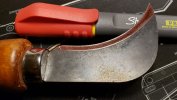- Joined
- Aug 9, 2021
- Messages
- 1,439
My wife uses a $9 linoleum knife to cut bananas off the tree. She asked if I could sharpen it. Foolishly, I said, "Sure!"
Half an hour later, I am not making a lot of progress, and it is apparent that the bevel along the edge is concave. There is no secondary grind that I can detect. The goniometer suggested that the edge was about 10 degrees per side but with a lot slop like you would expect from a dull convex bevel, but now that I think about it, a dull concave bevel would also give you a lot of slop in the angle measurement.
I am using the standard method of coloring the bevel with a marker and trying to file off the color. I am using the same diamond rod that I use for a recurved machete. As you can see from the photo, the rod is taking off color near the edge and at the top of the bevel but not much in between. There is no burr yet that I can feel. So the bevel must be concave
I am wondering if there is a reason that a linoleum knife should have a concave bevel? If so, what is a good way to sharpen it? I do not have any grinding wheels.
If there is no reason for a concave bevel, I assume that I will eventually get it flattened out. But reprofiling S90V on a TSProf is easier. :-(

Half an hour later, I am not making a lot of progress, and it is apparent that the bevel along the edge is concave. There is no secondary grind that I can detect. The goniometer suggested that the edge was about 10 degrees per side but with a lot slop like you would expect from a dull convex bevel, but now that I think about it, a dull concave bevel would also give you a lot of slop in the angle measurement.
I am using the standard method of coloring the bevel with a marker and trying to file off the color. I am using the same diamond rod that I use for a recurved machete. As you can see from the photo, the rod is taking off color near the edge and at the top of the bevel but not much in between. There is no burr yet that I can feel. So the bevel must be concave
I am wondering if there is a reason that a linoleum knife should have a concave bevel? If so, what is a good way to sharpen it? I do not have any grinding wheels.
If there is no reason for a concave bevel, I assume that I will eventually get it flattened out. But reprofiling S90V on a TSProf is easier. :-(

